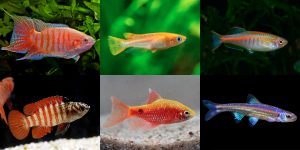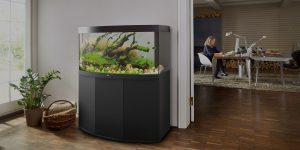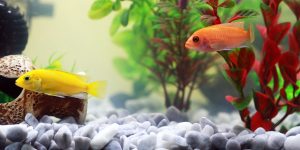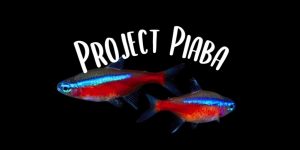Nocturnal fish, with their unique adaptations for thriving in low-light conditions, are a captivating addition to any aquarium. These fascinating creatures bring an interesting and dynamic element to any aquarium setup, creating a mesmerizing display during the nighttime hours. In this article, we’ll introduce to you five nocturnal fish species, each of which is amazing to keep.
Page contents
Characteristics and Behaviour of Nocturnal Fish
Nocturnal fish are a fascinating group of aquatic creatures that exhibit unique characteristics and behaviour. Unlike their diurnal counterparts, characterized by activity during the daytime, these nocturnal species are most active during the night, making them a captivating addition to most aquariums. Let’s explore some interesting aspects of these mysterious creatures.
Specialized Sensory Organs
Nocturnal fish have evolved specialized sensory organs to navigate and thrive in darkness. Many species possess barbels, which are slender, whisker-like appendages located near their mouths. These barbels serve as tactile sensors, helping the fish detect food and objects in low-light conditions. Nocturnal fish often have enlarged eyes that allow them to gather more light, enhancing their vision in dimly lit environments.
Secretive Behaviour During the Day
One notable behaviour exhibited by nocturnal fish is their secretive nature during the day. These fish tend to seek shelter and rest in secluded areas such as caves or dense vegetation to avoid predators and conserve energy. This behaviour is an adaptation that helps them survive in their natural habitats where they may encounter diurnal predators.
Different Activity Patterns
Nocturnal fish follow a distinct activity pattern compared to diurnal species. While diurnal fish are most active during daylight hours, nocturnal fish display peak activity levels during the night when they venture out for hunting and feeding purposes. The transition from day to night triggers a behaviour change known as crepuscular activity, where the fish become more active during twilight periods.
Nocturnal Fish Productivity
Nocturnal fish productivity refers to their ability to thrive and reproduce during the nocturnal period. These fish have adapted to low-light conditions, allowing them to efficiently search for food and engage in reproductive activities under the cover of darkness. Their unique behaviour and physiological adaptations contribute to their successful reproduction and survival.
A Handful of Nocturnal Fish Species to Know
Nocturnal fish are a fascinating addition to almost any aquarium. These unique creatures have adapted to thrive in dimly lit and even fully dark conditions, meaning their behaviour is most interesting during the evenings, overnight, and early mornings. If you’re considering adding some excitement and intrigue to your aquarium at these times, here are five nocturnal fish species that you should consider:
Bristlenose Pleco
The bristlenose pleco or bristlenose catfish (Ancistrus sp.) is a popular variety of nocturnal fish that is commonly kept in aquariums. These relatively small freshwater catfish are native to South America and are known for their unique appearance and behaviour. With their flattened bodies, sucker-like mouths, and rows of bristley appendages on male bristlenoses’ heads, they have a distinct look that sets them apart from other fish.

Appearance and Behaviour
Bristlenose plecos come in various colours and patterns, including shades of brown, grey, and black. They have a rugged armour-like body covered in bony plates, which helps protect them from potential predators. One of their most distinguishing features is the long bristles that adorn their faces. These bristles serve multiple purposes. For example, they help the fish navigate through rocky environments while searching for food, play a role in courtship rituals, and even act as a defence mechanism.
As nocturnal creatures, bristlenose plecos are most active during the night when they scavenge for food along the bottom of the tank. During the day, they tend to hide away in caves or under rocks to rest. Due to their peaceful nature and relatively small size (growing up to 15cm/6″), bristlenose plecos can be kept with a variety of tankmates without causing any issues.
Bristlenose Catfish Care
To provide optimal care for bristlenose plecos, it’s important to create an environment that mimics their natural habitat. Here are some key considerations:
- Water Parameters: Maintain stable water conditions with temperatures between 22-27°C (72-82°F) and pH levels ranging from 6.5-7.5.
- Tank Size: Provide ample space for these active fish by selecting an aquarium with a minimum capacity of 75 litres or roughly 20 gallons.
- Substrate: Bristlenose plecos are bottom-dwellers, so a fine sand substrate often suits this species best.
- Plants and Decor: When it comes to plants, bristlenose plecos can uproot delicate aquatic varieties, so be sure to choose more robust species or epiphytes like anubias and java ferns. Adding rocks and driftwood will also provide some places for sometimes-shy bristlenoses to hide.
Temperament
When it comes to character, bristlenose plecos are a relatively easy-going species that can be housed in most suitably sized aquariums. They are often chosen for community aquariums as species that will eat algae. They don’t typically bother other species or show aggression, but they might be sometimes slightly pushy over food.
Price
Bristlenose Plecos are readily available in most local aquarium shops. The price may vary depending on factors such as size, colour variation, and demand. On average, you can expect to pay around £8-£15 for a juvenile or sub-adult bristlenose pleco.
Kuhli Loach
The kuhli loach (Pangio kuhlii) is a popular species of largely nocturnal fish that can add a unique touch to your aquarium. These slender, eel-like fish are widely known for their interesting appearance and behaviour.
Appearance and Behaviour
Kuhli loaches have a distinctive appearance with long, snake-like bodies that are marked with vertical stripes. They typically have orange, brown, or black colouration, often with stripes, which helps them blend in with their surroundings. These fish are relatively small, growing up to 10cm/4″ in length on average.
Kuhli Loaches are primarily active during the night, making them perfect for nocturnal aquariums. During the day, they prefer to hide in caves or under rocks and plants. However, once the lights go out, these little creatures come alive! They will explore every nook and cranny of your tank, scavenging for food and interacting with other fish. Kuhli loaches are also known to be one of the aquatic fish that burrow in sand, and can sometimes not be seen for days!
Kuhli Loach Care
Creating the right environment for your kuhli loaches is essential to ensure their well-being. Here are some key factors to consider:
- Tank Size: Provide at least a 75-litre or 20-gallon tank for a small group of kuhli loaches, which thrive in numbers. More fish will require a larger tank.
- Water Parameters: Maintain a pH level around 6-7 and a temperature between 24-29°C (75-86°F).
- Substrate: Use fine sand or very small, smooth gravel as a substrate since these loaches love burrowing.
- Plants and Decor: Include plenty of live plants like java moss or anubias along with hiding spots within driftwood or even plastic pipes.
Temperament
Kuhli Loaches are generally peaceful and get along well with other non-aggressive fish species. However, they can be a bit shy and may feel stressed if kept with aggressive or larger tankmates. It’s best to choose tankmates who share similar water requirements and temperaments to ensure a harmonious aquarium community.
Price
The cost of kuhli loaches can vary depending on factors such as size and availability. On average, you can expect to pay around £4-£8 per fish.
Black Ghost Knifefish
The black ghost knifefish (Apteronotus albifrons) is a fascinating species of nocturnal fish that has captivated aquarium enthusiasts for many years with its unique appearance and behaviour. With its elongated body, dark colouration, and flowing finnage, this fish truly lives up to its name.
Appearance and Behaviour
The black ghost knifefish has a sleek black body that resembles a ghostly apparition gliding through the water. They have a long, somewhat eel-like shape which allows them to effortlessly manoeuvre through tight spaces. One of their most distinctive features is their ability to generate weak electrical discharges using specialized organs called electroreceptors. This unique trait helps them navigate in low-light conditions by sensing objects around them.
In terms of behaviour, these nocturnal creatures are primarily active during the night when they come out of hiding to search for food. They are known for their mostly peaceful nature but can be territorial towards other members of their own species or similarly shaped fish. Larger black ghost knifefish will also eat smaller tankmates given the chance. It’s important to provide them with plenty of hiding spots in the aquarium to make them feel secure.
Black Ghost Knifefish Care
To ensure the well-being of your black ghost knifefish, it’s crucial to create a suitable environment for them in your aquarium. Here are some key factors to consider:
- Tank Size: These fish require spacious tanks due to their size and swimming habits. A tank capacity of at least 280 litres (75 gallons) is best for a single adult.
- Water Parameters: Maintaining proper water parameters is essential for the health of these potentially sensitive fish. Aim for a pH level between 6.5 and 7.5 and a temperature in the range of 24-27.5°C (75-82°F).
- Substrate: Providing a soft substrate like sand or fine gravel is recommended, as it most closely mimics their natural habitat.
- Plants and Decor: Incorporating driftwood, rocks, and plants will create hiding places and best suit black ghost knifefish kept in aquariums, particularly as they grow.
Temperament
While generally peaceful, black ghost knifefish can exhibit aggression towards fish that resemble their own shape or colouring. It’s best to avoid housing them with aggressive or fin-nipping species. Ideal tankmates include peaceful community fish such as larger tetras and peaceful cichlids. Avoid keeping them with smaller species that can fit into their mouths as they may end up being eaten by larger knifefish.
Price
You can expect to pay between £10 and £40 for a black ghost knifefish depending on size and local availability.
Glass Catfish
Glass catfish (Kryptopterus sp.) are a fascinating variety of nocturnal fish that can make a unique addition to your aquarium. On appearances alone, it’s surely one of the most unique fish species available in the hobby.

Appearance and Behaviour
These transparent creatures are known for their slender bodies and delicate appearance, which gives them an almost ethereal quality. They have long, flowing fins and two pairs of barbels near their mouths, which they use to navigate their surroundings. Most people are amazed by these interesting, see-through fish that feel almost unreal at first glance.
Glass Catfish Care
For happy glass catfish, it’s vital to create an environment that mimics their natural habitat. Here are the things you should know if you want to keep these interesting oddballs:
- Tank Size: The ideal tank size for this species is around 120 litres/30 gallons or more, allowing them adequate space to swim freely as a group.
- Water Parameters: In terms of water temperature, the Glass Catfish thrives in tropical conditions ranging from 22-27°C (72-82°F) and with a pH between 6.5 to 7.5. Regular water changes are necessary to ensure a healthy environment for these potentially delicate fish long term.
- Substrate: Since these species are not bottom dwellers, it does not matter what kind of substrate you use.
- Plants and Decor: Glass catfish prefer tanks with plenty of hiding spots such as caves or dense vegetation. Providing driftwood or rocks can also be beneficial as they like to swim between these structures.
Temperament
One aspect worth considering when deciding on adding glass catfish to your aquarium is their peaceful, sometimes shy temperament. These fish are generally non-aggressive and can coexist nicely with other calm species such as small rasboras or gouramis. It’s best not to house them with aggressive or larger fish that may intimidate them.
Price
Glass catfish are relatively affordable, especially compared to many other unusual tropical fish species available in the market. You can expect prices of around £6 per fish.
Upside-Down Catfish
The upside-down catfish (Synodontis nigriventris) is a unique and fascinating species of nocturnal freshwater aquarium fish. With its distinct appearance and interesting behaviour, it’s become a deservedly popular choice for aquarium enthusiasts around the world.
Appearance and Behaviour
The upside-down catfish gets its name from its peculiar habit of swimming upside-down. This behaviour is not only intriguing but also serves as a survival mechanism. By swimming belly-up, they can easily feed on insects and other small organisms that float on the water’s surface.
These catfish typically reach around 7.5cm/3″ in length when fully grown but can grow larger. They usually sport a dark brown or black colouration, which helps them blend into their natural habitat of murky waters in Africa.
Upside-Down Catfish Care
To keep upside-down catfish happiest, it’s essential to recreate their natural environment as closely as possible. Here are some key factors to consider:
- Tank Size: Provide ample space for these surprisingly active swimmers by opting for a tank size of at least 120 litres/30 gallons.
- Water Parameters: Maintain clean water conditions with neutral pH levels (around 7). Keep the water temperature between 24-27.5°C (75-82°F), replicating their native habitat in Africa’s rivers.
- Substrate: You should use a smooth substrate like fine gravel or sand as larger or sharper pebbles or gravel can damage the sensitive mouths of this species. Upside-down catfish like to occasionally lay on the bottom of the tank so it’s vital to use an appropriate substrate.
- Plants and Decor: Adding lots of hiding places, like small ceramic tunnels, can create excellent hiding places for these unusual and comical fish. Plants, too, are appreciated.
Temperament
The upside-down catfish love to hang around with their own kind. Larger upside-down catfish may prey on much smaller species of both fish and crustaceans – especially shrimp. Other than that, they’re generally peaceful and won’t cause any harm in an appropriate community aquarium.
Price
Upside-down catfish prices vary depending on availability. Where readily available, prices start at under £5. Where less readily available, expect to pay closer to £10 per fish.
Wrapping Up
Nocturnal fish species can make fascinating additions to most aquariums, adding an element of mystery and intrigue to these underwater worlds. Incorporating nocturnal fish into your aquarium offers a great chance to observe their mesmerizing night-time activities and gain a deeper appreciation for the diversity of aquatic life.
Just remember to provide suitable hiding places within your tank to mimic their natural habitat and ensure they feel secure. Also consider adjusting the lighting schedule to accommodate their nocturnal lifestyle.
About the Author
This guest post comes courtesy of Jaime, editor of theaquariumkeeper.com, a fishkeeping blog covering different fish-related topics ranging from breeding guides to specific aquatic problems. Jaime has been in the aquarium hobby for many years and his knowledge gained from trial, error, and continuous research is reflected in content created on specific questions about this niche.






